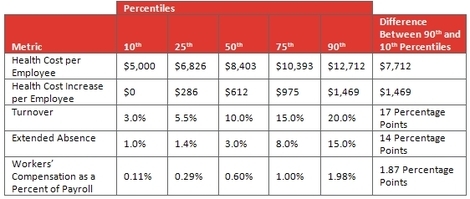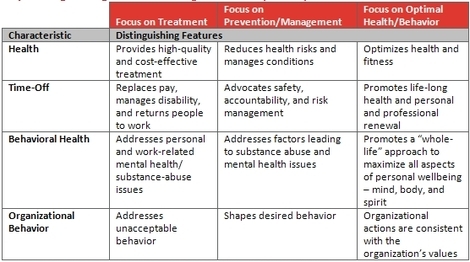| April 12, 2011 | Advertise | Join ASHHRA | |||

Is Your Health Care Organization a Healthy System?Health care organizations, just like most other employers in the United States, are facing an unprecedented tsunami of poor employee health. Chronic health problems, increased absence and disability, turnover of key talent and loss of productivity are undermining many hospitals' ability to properly execute their business strategy. Recognizing these factors, some forward-thinking HR leaders and administrators are taking steps to address both the health and the health care needs of their employees. These health-focused health care providers are partnering with their employees to create and implement preventive health care solutions that aim to optimize their health and behaviors, not just eliminate risks. What Outcomes Can Hospitals and Health Care Systems Expect? The study found significant variance in each of the outcome metrics reported – health cost per employee, health cost increase per employee, turnover, unscheduled absence, extended absence, and workers' compensation cost as a percentage of payroll. As the table below shows, the 90th percentile is always more than double the 10th percentile (the level at which 10 percent of respondents reported a lower outcome). This relationship is also consistent even after adjusting for industry and demographics. Differences in Outcome Metrics by Percentiles of Respondents*
* For each metric, the percentiles of respondents reflect the lowest to highest dollar amounts or percentages. To better understand the organizational drivers for this variance, Sibson developed a Healthy Enterprise Index, which rates organizations from zero to 100 percent, according to how well they partner with their employees on health initiatives. The average Healthy Enterprise Index score is 57 percent. Although not every health care organization will aim for a Healthy Enterprise Index of 100 percent, its leaders may want to determine their index and, if it is low, develop strategies to improve it. Sibson has found that a higher Healthy Enterprise Index is associated with lower health care costs. On average, a 10 percentage-point increase in the index equates to a $160 reduction in health care cost per participant. An organization that has an average of 1.5 dependents for each employee could experience a reduction in annual health care costs of $400 per employee by increasing its index by 10 percentage points. Participants in the top quartile of the Healthy Enterprise Index achieve better outcomes across the board, as shown in the following table. Comparison of Average Adjusted* Outcome Metrics for the Top Quartile Compared to All Others
* Sibson adjusted each outcome metric for various factors, such as industry and demographic (i.e., age and average family size). For information about which adjustments were applied to each metric, refer to the online supplement to this report that discusses the study methodology, which is available on the following page of Sibson's Web site: http://www.sibson.com/publications/surveysandstudies/HESsupp2.pdf The ROI of becoming a healthy hospital is potentially considerable. For example, a recent meta study (a study of studies) conducted by Harvard University concluded that the return can be 3.27:1 on medical costs and 2.73:1 on absence and related costs. The programs that were the subjects of the reviewed studies generally were crafted carefully with the intent of measuring an outcome. This suggests that hospitals need to design their healthy hospital initiatives carefully to ensure they, in time, will produce a healthy ROI. What Steps Should Health Care Organizations Take to Become Healthy?
In addition to the cost savings associated with being a healthy hospital, there may be productivity gains to the extent that healthy employees are more satisfied with their jobs and more engaged in their work than are unhealthy employees. Trying to become a healthy hospital right out of the blocks can be a daunting task that is outside the scope of most hospitals and health care organizations. A more realistic approach is to start by defining a strategy that clearly aligns with and supports the business strategy. Health care organizations can then begin by making investments that optimize success within the current culture. Many hospitals start promoting health and productivity by repackaging the programs and services they already have in place to support the strategy. They then add resources (e.g., health-risk assessments and screenings) to help employees and their families understand their risks and conditions and to better manage them through behavior modification (e.g., using health coaches, education, and other tools). So, How Healthy Is Your Organization?
A number of factors differentiate the three stages of a healthy hospital. For example, where a hospital in the first stage will primarily be reactive in treating conditions and dealing with unacceptable behavior, a hospital in the second stage will focus on managing risks and conditions by shaping behavior. A hospital in the third stage, however, will focus on optimizing health and behavior by maintaining a healthy culture that is evident at every level. In addition to this strategic orientation, each stage of maturity is characterized by its approach to addressing the various elements of its programs/initiatives, such as health plans, time-off programs, workplace support, behavioral health programs, communications, organizational behavior, and measurement and metrics. See the table below, for a sample of key distinguishing features. Key Distinguishing Features Along the Healthy Enterprise Continuum
Source: Sibson Consulting Conclusion Steven F. Cyboran is a vice president and consulting actuary in the Chicago office of Sibson Consulting. He leads Sibson's Healthy Enterprise Initiative and has been actively involved in a variety of projects focusing on cultural transformation. He can be reached at 312.984.8558 or scyboran@sibson.com. Glenn M. Alonzo is a senior vice president and national hospital and health care market leader in the Hartford office of Sibson Consulting. He can be reached at 860.678.3013 or galonzo@sibson.com. |
 |
155 North Wacker, Suite 400 Chicago, IL 60606 Ph.: 312.422.3720 Fax: 312.422.4577 E-mail: ashhra@aha.org Website: www.ashhra.org |


